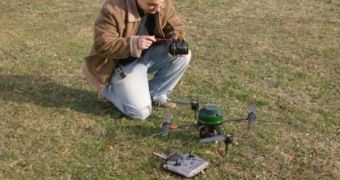Natural or artificial disasters can strike at any time, in any region of the globe, and can also cause massive amounts of devastation at ground zero, and in surrounding areas. In the first moments after the catastrophe, emergency response teams need to devise the best course of action, while under extreme stress, and experiencing the need to act as soon as possible. But, given a rushed decision, the whole rescue operation could turn into a fiasco. That's why experts at the Fraunhofer-Gesellschaft Institute (IITB), in Germany, have created a new damage-assessing tool, especially for this type of circumstances.
They've designed and constructed a prototype of a small, remote-controlled helicopter, which can be equipped with video cameras and other types of sensors, and can be flown over the affected areas, in search for survivors. Using data gathered from these machines, emergency response teams could elaborate the best course of action, according to the realities in the field. The “quadrocopter” can be flown either separately, or in swarms, which can provide 360-degree fields-of-view of the objective.
Due to the fact that the machine is only one meter (about three feet) in diameter, it can be flown inside collapsed buildings, and can steer clear of obstacles, as the operators guide themselves with images received from on-board cameras. The German researchers have big plans for their innovation. They want to create swarms that can fly themselves, or that can be flown by just a single emergency worker. That is to say, current versions of the quadrocopter need to be flown individually, which makes deploying large numbers of them both expensive and impractical.
Dr. Axel Bürkle, who is the project manager at the IITB, says that the team has also developed a piece of computer software to control larger numbers of the small, RC helicopters. “Our program enables the quadrocopters to coordinate their activities themselves. One of them can fly up close to victims to investigate their injuries while another reconnoiters the fastest route for getting them out,” the expert points out. He adds that the software is made of individual sections, or “agents,” which can be assigned to one of the quadrocopters.
Each of the agents is controlled by the software in a digital environment, and is given a specific task, such as the fly-by, close-up investigation, general surveillance, and so on. Upon receiving the commands, each of the agents executes them, but also steers clear of all other helicopters, so as to avoid the risk of collisions. The powerful relays on the quadrocopters allows them to beam back sounds, videos and images to control posts, which can then be analyzed by human experts, and acted upon.

 14 DAY TRIAL //
14 DAY TRIAL //